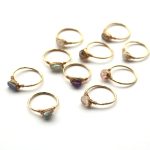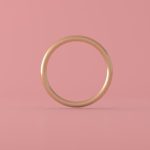Costume jewelry began as an affordable way for people to enjoy the look of fashionable and luxurious fine jewelry without having to pay a significant amount of money. Commonly made with synthetic materials such as glass, resin, clay, plastic, and metal alloys, costume jewelry often mimics the look and style of high-end designer pieces.
As this type of jewelry is typically more affordable and less valuable than precious gemstones and metals, it’s important to understand how to properly repair costume jewelry at home in order to avoid unnecessary costs associated with hiring professional services.
Knowing how to care for your costume jewelry is key; however, occasionally something may go wrong and improper cleaning or mishandling can cause damage that needs to be fixed. With the right skills, tools, and knowledge on how specifics repairs need to be done on these types of pieces at home-without requiring additional cost-can be a manageable task. Here are a few tips that will show you a simple process for repairing broken pieces of costume jewelry.
One technique involves using epoxy glue; start by carefully selecting an bonding ingredient that won’t react with any materials found in the piece you are repairing. Then use thin tweezers or other specialized tools; if the pieces are too small or configured in a unique way then this step may require some patience.
Before gluing anything together use an exacto knife or sandpaper lightly sand down any surfaces that need adhesion creating a better area for glueing them back together. The next steps involve squeezing out a small amount of glue onto one side then pressing it into the other piece securely until both sides come together forming a bond.
Identifying the Problem
When it comes to costume jewelry, there are many types of issues that can occur over time. These include broken clasps and links, tarnishing, discoloration, corrosion and overall deterioration of the item due to wear and tear. For example, heavy use can cause the metal plating of pieces to wear away quickly. In addition, exposure to harsh chemicals like chlorine or perspiration can cause discoloration or even corrosion of metals. These problems affect the appearance and longevity of the piece.
To prevent these problems from occurring in the first place, it is important to take good care of costume jewelry. This includes storing pieces carefully in a secure box or bag away from humidity and direct sunlight as well as avoiding contact with any liquids including water and chemical solvents such as bleach or alcohol.
When cleaning costume jewelry at home it is recommended to use a gentle jewelry cleaner such as those available on the market specifically formulated for costume jewelry; avoid using any abrasive cleaners which could damage more delicate pieces.
For minor repairs like replacing hooks or clasps on necklaces and bracelets, this can typically be carried out with some basic hand tools such as needle nose pliers and wire cutters depending on how intricate the repairs needs to be.
It is important when carrying out these repairs that you take extra precaution not to scratch or damage the metal during an adjustment or simple repair job – Be sure your tools are clean before use to minimize any risk of further tarnishing the jewelry piece.
If attempting any complex repairs beyond those basic DIY adjustments, it is better to take your item into a professional jeweler for assistance instead.
Gather the Supplies Needed
For costume jewelry owners who want to repair their own pieces, the first step is to gather together the necessary supplies and tools. While some materials will be more specialized, many items needed for costume jewelry repair can be found in most basic toolboxes or at local hobby stores. It is important to use the right materials when dealing with delicate jewelry items; otherwise, a person could damage their piece even further.
Tweezers are an essential tool for repairing costume jewelry as they allow for precise handling of delicate components. Specialty tweezers may be needed in order to reach into small crevices or grasp hold of tiny objects.
Pliers are used when heavier manipulation of the materials is necessary such as re-shaping or reshaping clasps and cords that have lost their shape and structure over time. Needles might come in handy for fixing broken threads or for stitching up larger rips, tears, and other unravelled areas that may occur from wear and tear over time.
If any of these specialized tools are not available at a local store, they can easily be found online at hobby sites or retailers like eBay or Amazon. When ordering these supplies it is important to research all vendors before making a purchase so that you can ensure you’re getting quality materials that will help make your repairs properly done and last longer than if you were to use inferior products.
Once all the proper supplies have been gathered together, then you can start on repairing your beloved pieces of costume jewelry.
Gathering Materials
Costume jewelry is an ideal accessory for adding a unique touch to any outfit. However, over time regular wear and tear can damage this type of jewelry, which means you might need to repair it from time to time. Fortunately, with the right materials, you can easily make repairs at home.
When it comes to gathering materials for repairing costume jewelry, there are plenty of options available. You can find synthetic gemstones and colored beads at most craft stores. These store provide affordable prices and large selections so you can easily pick out the best piece that matches the rest of your jewelry.
You’ll also want to grab some adhesive for holding pieces in place when you’re ready to start repairs. Hot glue guns as well as craft specific glues such as E6000 provide strong bonds and don’t often require additional support from pins or wires in order to stay put.
Tools such as snippers are also helpful when it comes to working on costume jewelry. The extra tip length provides more stability so that cuts will be nice and clean instead of jagged or uneven like they could be with shorter tips or scissors. Pliers come in handy too if you need assistance when it comes to holding pieces in place prior to adhering them together.
If your costume jewelry contains stones or crystals that are loose due to normal wear and tear then tweezers can also work wonders when trying to secure them in into their correct positions again. Threaded items such as necklaces can often times become tangled up from appearing display cases or closets; these issues may require using a needle threaded with waxed dental floss help get them back into form quickly.
Ready the Jewelry
Before attempting to repair costume jewelry at home, it is important to ensure the pieces being used are taken apart correctly. It is best to disassemble a piece by carefully removing any closures such as clasps or pins. Make sure that all parts are laid out in order and organized so that there is no confusion when it is time to reassemble the piece.
Once all of the parts are laid out, each piece should be inspected for visible signs of damage. Maintaining awareness for any marks or scratches will be beneficial when attempting to repair the jewelry. If a part cannot be found, take a look at stores or online sites which specialize in jewelry supplies to find replacement parts if needed.
Fixing Broken Clasps: A demonstration of methods that can be used to fix clasps such as pliers and epoxy glue also need to included.
Broken clasps are amongst the most common issues occurring with costume jewelry pieces, and fortunately can easily be repaired with simple supplies found around many homes. Pliers are commonly utilized for this type of repair since they can help straighten bent portions of the clasp which may not close securely anymore; however, extreme care must be taken when using pliers on delicate metal pieces so as not to cause additional damage.
If it is not possible to fix a traditional closure by utilizing tools like pliers, another option would involve using non-toxic epoxy glue containing hardening agents and fillers coupled with strong adhesives; depending on the severity of the issue, some pieces may require multiple coats of epoxy glue before achieving a secure fitment once again.
Adding Backs To Missing Stones: Show how adhesive such as E6000 is used when replacing missing stones such as rhinestones or other gems
When dealing with missing stones from costume jewelry, an excellent adhesive for this particular job would include E6000 Glue specifically designed for use on fabric and other materials prominently featured in costume jewelry designs.
Before applying the E6000 Glue, prepare the stone and affected area on the jewelry piece by ensuring both areas are clean and free from dust particles; then dispense a small amount of E6000 onto either component’s surfaces depending on design preference prior to gently pressing both sides together until adherement occurs (this process takes about twenty minutes on average).
After this step is complete, allow full drying time in excess of twenty four hours while holding both components together until complete drying has occurred before utilizing in its intended fashion once more.
Step-by-Step Repair Techniques
Costume jewelry can often make us look beautiful and it is important to keep them in shape. It is only when you wear them that you realize how easily they get damaged due to careless handling or improper maintenance. If your costume jewelry has been damaged, it is possible to repair it at home without having to send it off for professional repairers.
However, this should not be attempted without taking into consideration certain things like the temperature and humidity of the place where you are doing the repairs. For instance, heat and moisture could cause certain types of metals to oxidize or tarnish, making them more difficult to repair. It is also important to select the right techniques for certain types of repairs so as not to cause further damage or risks of harm in the process.
The first step before attempting any jewelry repairs would be to clean your work area thoroughly so as not to leave behind dirt and dust particles that could interfere with your work. After this is done, examine the piece of jewelry and get an idea about what needs perfecting before starting out with actual repairing procedures.
While some general repairs can be done with simple tools like adhesives and pliers, fragile costume jewelries should be treated with extra care as they have delicate details that can break easily if mishandled.
After selecting proper supplies based on the type of repair needed, follow through the directions carefully while operating the tools. Take a few breaks in between so as not to tire yourself out while working on delicate projects. And remember that even minute details could elevate a basic costume jewelry from looking dull and boring into something much more exquisite.
Thus being patient while polishing small irregularities with fine grade sandpapers will go a long way in completing a successful repair job at home. As such, by familiarizing oneself well enough prior doing actual repairs, one can effectively fix their own costume jewelries at home without seeking out costly services from professional repairers.
Finishing Touches
After you have successfully repaired the costume jewelry, it is very important to properly clean, finish and seal the piece in order to keep it looking like new and avoid damage. This can be done with a variety of items depending on the material your jewelry is made from. To clean costume jewelry that’s made of gold or silver, make sure to use only a soft cloth to remove dirt and polish off any tarnish.
When cleaning stones or pearls, use lukewarm water with mild soap and a soft toothbrush to dislodge dirt particles. Once you have finished cleaning the pieces thoroughly, go over them again with a soft cloth dipped in warm water to fully remove any remaining residue.
After you have successfully cleaned the piece of costume jewelry, it is time for finishing touches. To give your costume jewelry an extra shine and sparkle you can use specific polishes or sprays designed specifically for metal jewelry such as silver dips or gold cleaners. Avoid using anything abrasive as this could scratch the surface of the item.
You should also avoid using ammonia-based cleaners or harsh chemicals as these can cause discoloration and fading over time. It’s imperative that you take extra precaution when polishing stones since some may be sensitive to certain products which could cause cracking if exposed to too much pressure from polishing tools or liquids.
Finally, once your jewelry has been cleaned and polished it needs to be sealed properly so it doesn’t collect dust and debris which can chip away at its beauty over time. The best way to seal costume jewelry depends on what type of material was used for the piece (gold, silver, etc.)
For example, a lacquer spray is preferable for gold-plated items since it forms a barrier between your skin’s oils and metals helping prolong their life span.
For silver plated pieces, an antique wax should be used instead while stones need an extra layer of protection using gemstone sealant after they’ve been secured in place by gluing them down. Applying these steps will guarantee that your costume pieces stay looking radiant for many years.
Final Thoughts
It is essential for those that own costume jewelry to understand the basics when it comes to repairing it. The process of repairing costume jewelry does not need to be overly complicated. There are a few simple tools, a bit of knowledge about basic jewelry repairs, and attention to detail that will enable any novice jewelry repair enthusiast to make minor repairs from the comfort of their home.
The first step when performing at-home jewelry repairs is locating all of the necessary materials. Most costume jewelry repairs can be completed with minimal materials and tools; small screwdrivers, pliers, small files, and in some cases, nail clippers or other sharp implements may be required.
Materials such as glue and epoxy are also vital for certain repair procedures. Once the material list has been compiled, the DIY jeweler can begin work on making their jewelry look as good as new again.
While it is possible for anyone comfortable with using tools to perform basic costume jewelry repairs at home, it is important to remember that if more complex repairs are needed then seeking out a professional jeweler may be the best option available. It’s imperative to bear in mind any potential risks associated with making intricate alterations or adjustments to delicate pieces of jewelry – mistakes can either render items beyond repair or result in irreparable damage being done.
Additionally, obtaining professional advice about any further maintenance options available could be beneficial prior to commencing any major improvement work on fragile or old pieces.
As such, an emphasis should be placed on seeking professional assistance when performing costume jewelry repairs – though this should not deter anyone looking for an uncomplicated way of restoring their beloved adornments back into shape again.
After reading through a short rundown on how to expertly repair piece of costume jewelry at home each reader should feel confident enough having gained some knowledge regarding the whole process yet remain alert enough aware of their limitations when attempting complicated tasks themselves – guidance from experts never hurts.
Furthermore it might be beneficial adding a section dedicated solely answering questions readers might have concerning costume jewellery they intend executing DIY repairs upon?

Welcome to my jewelry blog! My name is Sarah and I am the owner of this blog.
I love making jewelry and sharing my creations with others.
So whether you’re someone who loves wearing jewelry yourself or simply enjoys learning about it, be sure to check out my blog for insightful posts on everything related to this exciting topic!





